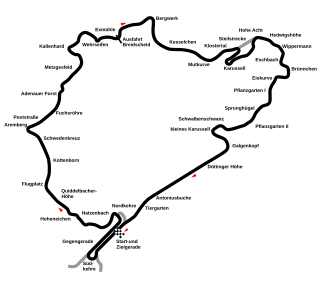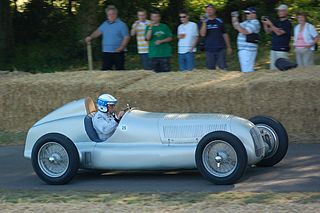
Tazio Giorgio Nuvolari was an Italian racing driver. He first raced motorcycles and then concentrated on sports cars and single-seaters. A resident of Mantua, he was known as 'Il Mantovano Volante' and nicknamed 'Nivola'. His victories—72 major races, 150 in all—included 24 Grands Prix, five Coppa Cianos, two Mille Miglias, two Targa Florios, two RAC Tourist Trophies, a Le Mans 24-hour race, and a European Championship in Grand Prix racing. Ferdinand Porsche called him "the greatest driver of the past, the present, and the future."

Raymond Sommer was a French motor racing driver. He raced both before and after WWII with some success, particularly in endurance racing. He won the 24 Hours of Le Mans endurance race in both 1932 and 1933, and although he did not reach the finishing line in any subsequent appearance at the Le Mans, he did lead each event until 1938. Sommer was also competitive at the highest level in Grand Prix motor racing, but did not win a race. He won the French Grand Prix in 1936, but the event that year was run as a sports car race. After racing resumed in the late 1940s, Sommer again won a number of sports car and minor Grand Prix events, and finished in fourth place in the 1950 Monaco Grand Prix, the second round of the newly-instituted Formula One World Drivers' Championship. He was killed toward the end of 1950, when his car overturned during a race at the Circuit de Cadours.
Grand Prix motor racing, a form of motorsport competition, has its roots in organised automobile racing that began in France as early as 1894. It quickly evolved from simple road races from one town to the next, to endurance tests for car and driver. Innovation and the drive of competition soon saw speeds exceeding 100 miles per hour (160 km/h), but because early races took place on open roads, accidents occurred frequently, resulting in deaths both of drivers and of spectators.

Achille Varzi was an Italian Grand Prix driver.

Luigi Cristiano Fagioli, nicknamed "the Abruzzo robber", was an Italian motor racing driver. He is currently the oldest driver to win a race in Formula One, also being the only race winner born outside the 20th century.

Lorenzo Bandini was an Italian motor racing driver who raced in Formula One for the Scuderia Centro Sud and Ferrari teams.

Paul Pietsch was a racing driver, journalist and publisher from Germany, who founded the magazine Das Auto. He was the first German ever to take part in a Formula One Grand Prix.

The 1935 German Grand Prix was a Grand Prix motor race held at the Nürburgring on 28 July 1935.

The Alfa Romeo P3, P3 monoposto or Tipo B was a classic Grand Prix car designed by Vittorio Jano, one of the Alfa Romeo 8C models. The P3 was first genuine single-seat Grand Prix racing car and Alfa Romeo's second monoposto after Tipo A monoposto (1931). It was based on the earlier successful Alfa Romeo P2. Taking lessons learned from that car, Jano went back to the drawing board to design a car that could last longer race distances.

The Phillip Island Grand Prix Circuit is a motor racing circuit located near Ventnor, on Phillip Island, Victoria, Australia. The current circuit was first used in 1956.

The Ulster Grand Prix is a motorcycle race that takes place on the 7.3-mile Dundrod Circuit made up entirely of closed-off public roads near Belfast, Northern Ireland. The first races took place in 1922 and in 1935 and 1948 the Fédération Internationale de Motocyclisme gave it the title Grand Prix d'Europe. The Ulster Grand Prix was included as one of the races in the inaugural 1949 Grand Prix motorcycle racing season, a place it held until 1971. It also counted for the Formula TT Championship between 1979 and 1990. According to the race organisers, it is the fastest road race in the world.
The 1935 Grand Prix season was the third AIACR European Championship season. There were 35 non-championship races and seven races that counted for the European Championship. The championship was won by Rudolf Caracciola, driving for the Mercedes-Benz team.
Antonio Brivio was an Italian bobsledder and racing driver.

Malcolm Clarke Stewart was an Australian racing driver. He was known as the "Jolly Green Giant" for his disposition and height.

The Mercedes-Benz W25 was a Grand Prix racing car designed by Daimler-Benz AG for the 1934 Grand Prix season, in which new rules were introduced, and no championship was held. In 1935, the European Championship was resumed, and it was won by Rudolf Caracciola in a W25. In modified form, the W25 remained in use until 1937, when it was succeeded by the Mercedes-Benz W125.
The 1935 French Grand Prix was a Grand Prix motor race which was held at Montlhéry, France on 23 June 1935. The race lasted 500km and was won by Rudolf Caracciola driving a Mercedes-Benz.

The Maserati 8CM was a Grand Prix race car produced by Italian manufacturer Maserati in Bologna between 1933 and 1935.
The 1935 Monaco Grand Prix was a Grand Prix motor race held on 22 April 1935.
Mesa (1932–1941) was a French Thoroughbred racehorse and broodmare. She showed very good form as a juvenile when she won two races and finished third in the Grand Criterium. In the following year she was sent to England where she won the 1000 Guineas and looked unlucky when finishing third in Epsom Oaks. She also finished second in the Prix du President de la Republique and the Prix de La Jonchere and ran fifth in the Grand Prix de Paris. She made a very promising start to her time as a broodmare before dying at the age of nine.

Charles Pierre Elie Montier was a French racing driver and automotive engineer whose race entries included the inaugural 24 Hours of Le Mans.














